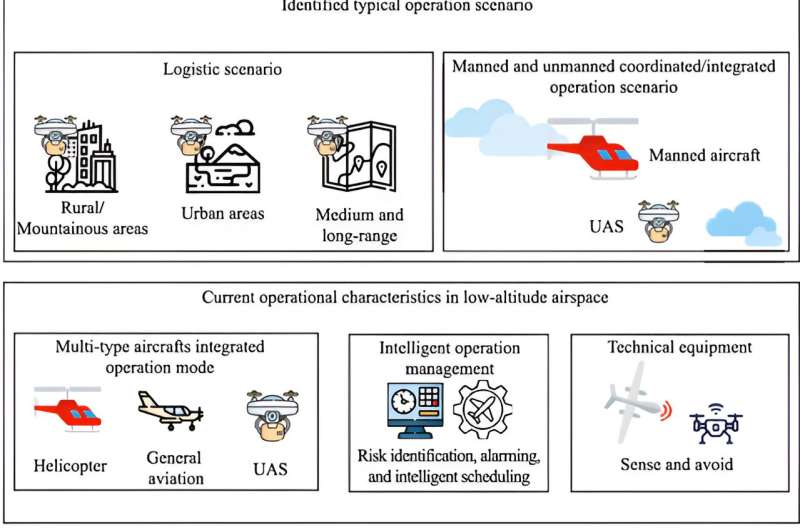This article has been reviewed according to Science X's editorial process and policies. Editors have highlighted the following attributes while ensuring the content's credibility:
fact-checked
proofread
The exploration and practice of low-altitude airspace flight service and traffic management in China

As China propels itself into a new era of aviation with its significant advancements in unmanned aerial systems (UAS), the nation is on the brink of a transformative shift in low-altitude airspace management. These changes are driven by an urgent need to integrate a burgeoning number of unmanned aircraft into the national airspace, posing unique challenges and opportunities for regulation, technology, and industry practices.
At the forefront of this evolution are the challenges presented by the digital, networked, and intelligent nature of UAS operations. Traditional aviation regulations and technical systems are under pressure to evolve rapidly to ensure safe, efficient, and integrated airspace usage by a diverse array of new players, including commercial drones for logistics, environmental monitoring, and potentially passenger transport.
China has historically maintained a complex airspace classification system, traditionally dominated by military and commercial aviation. However, since 2010, the reform for low-altitude airspace management has been initiated to incorporate general aviation and now UAS. This includes establishing low-altitude flight service support systems spearheaded by the Civil Aviation Administration of China (CAAC).
One of the notable developments in this area is the explosive growth of the UAS industry, which has seen China become a world leader in drone manufacturing. Drones in China are now widely used in several sectors, significantly impacting the logistics, agriculture, and environmental sectors. The flight hours of UAS have notably surpassed those of manned aircraft, highlighting the shift toward unmanned aviation.
The integration of UAS into the national airspace is multifaceted, involving the adaptation of UAS traffic management systems, technological tests, and verification of new operational concepts. China is exploring and taking cues from international practices, to shape its regulatory framework and operational strategies. This includes the adoption of advanced traffic management systems to facilitate the safe and efficient movement of both manned and unmanned aircraft in shared airspace.
The operational scenarios for UAS in China are diverse, ranging from UAS logistics in urban and rural settings to coordinated operations with manned aircraft. The benefits of UAS in logistics are particularly pronounced, offering high efficiency and reduced costs compared to traditional methods. In urban areas, drones deliver everything from consumer goods to emergency medical supplies, showcasing their critical role during emergencies like the COVID-19 pandemic.
However, the rapid integration of drones into populated urban areas and busy flight corridors brings significant challenges. These include ensuring the safety of manned and unmanned aircraft, integrating advanced traffic management technologies, and developing operational standards that accommodate the unique needs of UAS operations.
Looking forward, China is poised to expand the role of UAS significantly. This includes broader applications in passenger transport and increased use in international logistics, necessitating continuous advancements in technology and regulatory frameworks to ensure safety and efficiency.
As China continues to refine its approach to low-altitude airspace management, the global aviation industry watches closely. The country's journey toward fully integrated UAS operations not only highlights its technological prowess but also its potential to set international standards in unmanned aviation.
With ongoing research, development, and regulatory adjustments, China is setting the stage for a future where drones are a central element of the national airspace ecosystem. The work is published in the journal Green Energy and Intelligent Transportation.
More information: Xiangmin Guan et al, The exploration and practice of low-altitude airspace flight service and traffic management in China, Green Energy and Intelligent Transportation (2024). DOI: 10.1016/j.geits.2024.100149



















